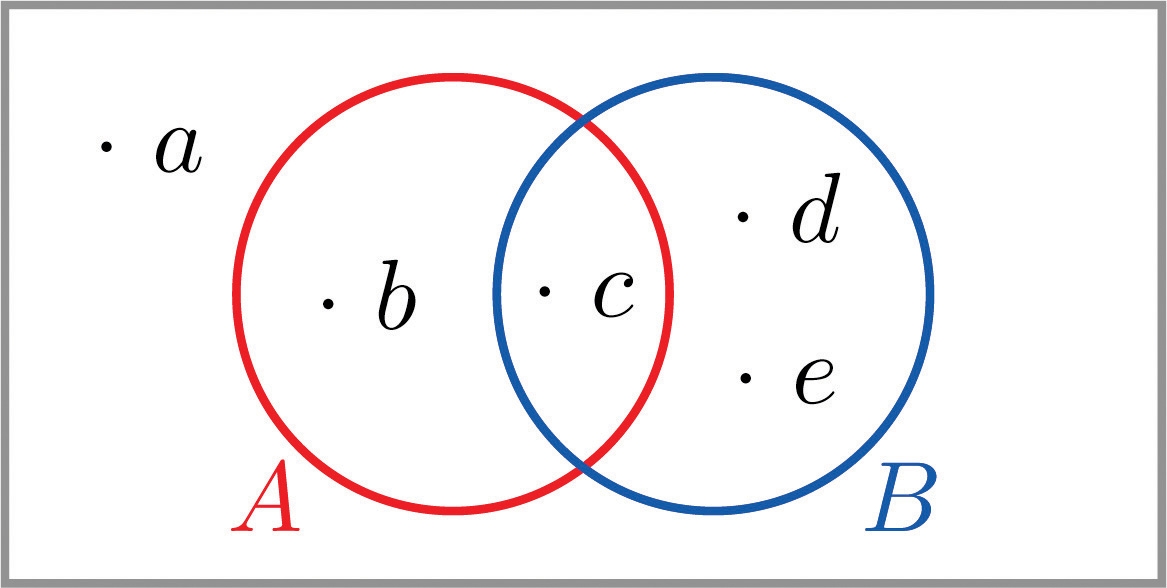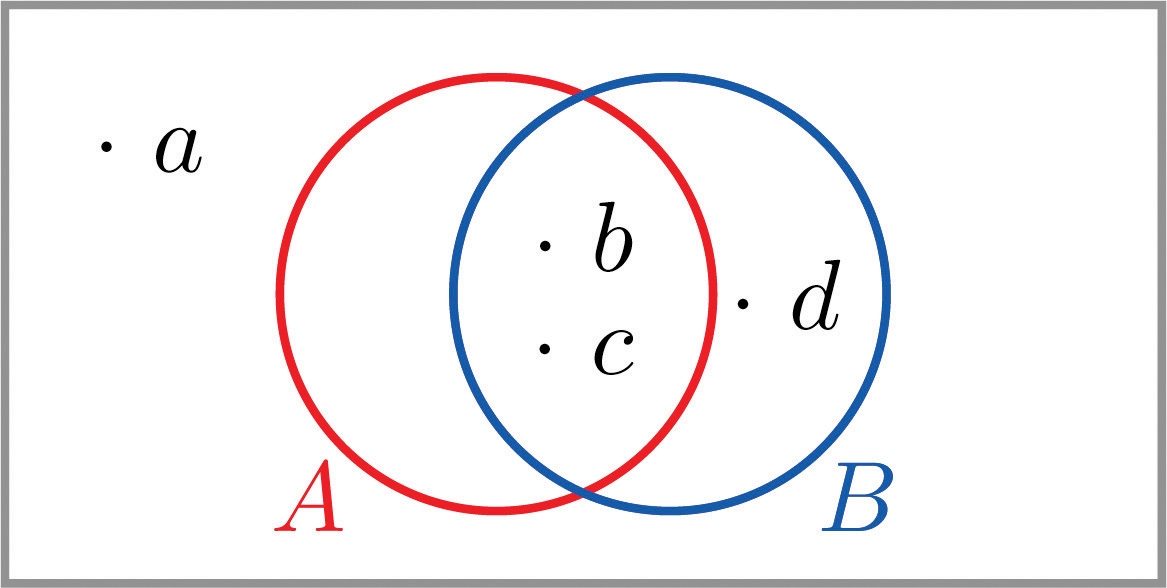3-2. Exercises
1. BASIC
Ex 1. For the sample space identify the complement of each event given.
Ex 2. For the sample space identify the complement of each event given.
(the “empty” set that has no elements)
Ex 3. The sample space for three tosses of a coin is
Define events
List the outcomes that comprise and .
List the outcomes that comprise , , and .
Assuming all outcomes are equally likely, find , , and .
Determine whether or not and are mutually exclusive. Explain why or why not.
Ex 4. For the experiment of rolling a single six-sided die once, define events
List the outcomes that comprise and .
List the outcomes that comprise , , , and .
Assuming all outcomes are equally likely, find , and .
Determine whether or not T and G are mutually exclusive. Explain why or why not.
Ex 5. A special deck of 16 cards has 4 that are blue, 4 yellow, 4 green, and 4 red. The four cards of each color are numbered from one to four. A single card is drawn at random. Define events
List the outcomes that comprise and
List the outcomes that comprise , , , , , and
Assuming all outcomes are equally likely, find the probabilities of the events in the previous part.
Determine whether or not and are mutually exclusive. Explain why or why not.
Ex 6. In the context of the previous problem, define events
List the outcomes that comprise and
List the outcomes that comprise and .
Assuming all outcomes are equally likely, find the probabilities of the events in the previous part.
Determine whether or not and are mutually exclusive. Explain why or why not.
Ex 7. The Venn diagram provided shows a sample space and two events A and B. Suppose and . Confirm that the probabilities of the outcomes add up to 1, then compute the following probabilities.

two ways: (i) by finding the outcomes in and adding their probabilities, and (ii) using the Probability Rule for Complements.
two ways: (i) by finding the outcomes in and adding their probabilities, and (ii) using the Additive Rule of Probability.
Ex 8. The Venn diagram provided shows a sample space and two events and . Suppose and . Confirm that the probabilities of the outcomes add up to 1, then compute the following probabilities.

two ways: (i) by finding the outcomes in and adding their probabilities, and (ii) using the Probability Rule for Complements.
two ways: (i) by finding the outcomes in and adding their probabilities, and (ii) using the Additive Rule of Probability.
Ex 9. Confirm that the probabilities in the two-way contingency table add up to 1, then use it to find the probabilities of the events indicated.
U
V
W
A
0.15
0.00
0.23
B
0.22
0.30
0.10
.
Determine whether or not the events and are mutually exclusive; the events and .
Ex 10. Confirm that the probabilities in the two-way contingency table add up to 1, then use it to find the probabilities of the events indicated.
R
S
T
M
0.09
0.25
0.19
N
0.31
0.16
0.00
Determine whether or not the events and are mutually exclusive; the events and .
2. APPLICATIONS
Ex 11. Make a statement in ordinary English that describes the complement of each event (do not simply insert the word “not”).
In the roll of a die: “five or more.”
In a roll of a die: “an even number.”
In two tosses of a coin: “at least one heads.”
In the random selection of a college student: “Not a freshman.”
Ex 12. Make a statement in ordinary English that describes the complement of each event (do not simply insert the word “not”).
In the roll of a die: “two or less.”
In the roll of a die: “one, three, or four.”
In two tosses of a coin: “at most one heads.”
In the random selection of a college student: “Neither a freshman nor a senior.”
Ex 13. The sample space that describes all three-child families according to the genders of the children with respect to birth order is
For each of the following events in the experiment of selecting a three-child family at random, state the complement of the event in the simplest possible terms, then find the outcomes that comprise the event and its complement.
At least one child is a girl.
At most one child is a girl.
All of the children are girls.
Exactly two of the children are girls.
The first born is a girl.
Ex 14. The sample space that describes the two-way classification of citizens according to gender and opinion on a political issue is
where the first letter denotes gender (m: male, f: female) and the second opinion ( : for, : against, : neutral). For each of the following events in the experiment of selecting a citizen at random, state the complement of the event in the simplest possible terms, then find the outcomes that comprise the event and its complement.
The person is male.
The person is not in favor.
The person is either male or in favor.
The person is female and neutral.
Ex 15. A tourist who speaks English and German but no other language visits a region of Slovenia. If 35% of the residents speak English, 15% speak German, and 3% speak both English and German, what is the probability that the tourist will be able to talk with a randomly encountered resident of the region?
Ex 16. In a certain country 43% of all automobiles have airbags, 27% have anti-lock brakes, and 13% have both. What is the probability that a randomly selected vehicle will have both airbags and anti-lock brakes?
Ex 17. A manufacturer examines its records over the last year on a component part received from outside suppliers. The breakdown on source (supplier , supplier ) and quality ( : high, : usable, : defective) is shown in the two-way contingency table.
0.6937
0.0049
0.0014
0.2982
0.0009
0.0009
The record of a part is selected at random. Find the probability of each of the following events.
The part was defective.
The part was either of high quality or was at least usable, in two ways: (i) by adding numbers in the table, and (ii) using the answer to (a) and the Probability Rule for Complements.
The part was defective and came from supplier .
The part was defective or came from supplier , in two ways: by finding the cells in the table that correspond to this event and adding their probabilities, and (ii) using the Additive Rule of Probability.
Ex 18. Individuals with a particular medical condition were classified according to the presence ( ) or absence ( ) of a potential toxin in their blood and the onset of the condition ( : early, : midrange, : late). The breakdown according to this classification is shown in the two-way contingency table.
0.012
0.124
0.013
0.170
0.638
0.043
One of these individuals is selected at random. Find the probability of each of the following events.
The person experienced early onset of the condition.
The onset of the condition was either midrange or late, in two ways: (i) by adding numbers in the table, and (ii) using the answer to (a) and the Probability Rule for Complements.
The toxin is present in the person’s blood.
The person experienced early onset of the condition and the toxin is present in the person’s blood.
The person experienced early onset of the condition or the toxin is present in the person’s blood, in two ways: (i) by finding the cells in the table that correspond to this event and adding their probabilities, and (ii) using the Additive Rule of Probability.
Ex 19. The breakdown of the students enrolled in a university course by class ( : freshman, : sophomore, : junior, : senior) and academic major ( : science, mathematics, or engineering, : liberal arts, : other) is shown in the two-way classification table.
Class
Major
92
42
20
13
368
167
80
53
460
209
100
67
A student enrolled in the course is selected at random. Adjoin the row and column totals to the table and use the expanded table to find the probability of each of the following events.
The student is a freshman.
The student is a liberal arts major.
The student is a freshman liberal arts major.
The student is either a freshman or a liberal arts major.
The student is not a liberal arts major.
Ex 20. The table relates the response to a fund-raising appeal by a college to its alumni to the number of years since graduation.
Years Since
Graduation
Response
0–5
6–20
21–35
Over 35
Positive
120
440
210
90
None
1380
3560
3290
910
An alumnus is selected at random. Adjoin the row and column totals to the table and use the expanded table to find the probability of each of the following events.
The alumnus responded.
The alumnus did not respond.
The alumnus graduated at least 21 years ago.
The alumnus graduated at least 21 years ago and responded.
3. ADDITIONAL EXERCISES
Ex 21. The sample space for tossing three coins is
List the outcomes that correspond to the statement “All the coins are heads.”
List the outcomes that correspond to the statement “Not all the coins are heads.”
List the outcomes that correspond to the statement “All the coins are not heads.”
Last updated
Was this helpful?